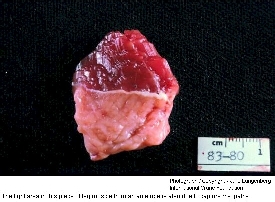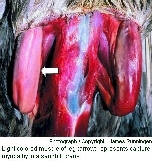| Exertional
or Capture Myopathy |
|
| |
| Risk Factor |
-
Exertional or capture myopathy (disease of the muscle) is a
non-infectious disease of muscles that is characterized by damage to
muscle tissues brought about by physiological changes, usually
following extreme exertion, struggle and/or stress.
|
| Images |
|
Click on images to enlarge. |
 |
 |
|
Exertion
myopathy evident in leg muscle of a pronghorn antelope. |
Light colored
leg muscle of a sandhill crane represents exertion myopathy. |
|
| Distribution |
|
Geographic: |
-
The potential for this condition can occur anywhere animals are pursued
or trapped.
|
|
Seasonality: |
-
All year. Warm weather can exacerbate this condition.
|
|
| Species Affected |
-
Both mammals and birds of all ages and sexes are susceptible to this
disease.
-
Species differ in their susceptibility to exertional myopathy because of
physical and behavioral attributes. It is most commonly seen
in wild
ungulates in British Columbia.
|
|
| Mechanisms of Action / Signs and Symptoms |
-
Signs vary depending on species, cause of exertion and the types of
biochemical imbalances that lead to muscular damage. It may be seen
peracutely (immediately),
acutely (within minutes
or hours) or
chronically (days or weeks).
-
Early signs include
increased breathing and heart rates, increased body temperature, or
sudden death.
-
Additional signs include:
depression, muscle stiffness, weakness, tremors, incoordination, or
shock, which may appear within
hours to days following severe exertion. If the animal survives,
residual signs may last as long as a month.
-
Urine of affected animals
may be red to brown because of broken down components of muscle
moving through the kidneys.
-
Animals that do not
initially die may be predisposed to kidney failure, predation and
accident.
-
Muscles may appear pale and
wet or very dark red and dry, with variable amounts of
hemorrhage and
edema present.
-
Kidneys may appear swollen,
and multiple
hemorrhages and
edema may be present in the
lungs.
-
Nutritional imbalances such as selenium
deficiency may predispose animal to developing exterional myopathy.
-
In severe cases, exertional
myopathy results in death of the animal.
|
| Meat Edible? |
-
Meat from an animal with exertional myopathy is suitable for human
consumption, although muscle damage may change the flavor and will
decrease the spoilage time of the meat.
|
| Prevention |
-
This condition may occur through normal life-history events, particularly
when prey species try to escape predators; however, it is more
commonly associated with strenuous use of muscles in the forelimbs
and hindlimbs when wild
ungulates are captured and handled.
-
This condition is extremely
difficult to treat and is best to avoid through prevention.
-
Prevention relies on methods
that reduce stress to animals, minimizing pursuit,
struggling and handling time, selecting appropriate weather
conditions to handle animals, ensuring proper methods of capture and
handling, and ensuring animals are released or placed in less
stressful conditions as quickly as possible.
|
| Samples for Diagnosis |
-
Portions of affected muscles from different areas of the body as well as
sections of heart and kidney tissue should be stored in formalin and
submitted for microscopic examination.
|
| Further Reading |
-
Alaska Department of Fish and Game – Exertional Myopathy
-
Pennsylvania Game Commission – Exertional Myopathy
-
Spraker T.R. 1993. Stress and Capture Myopathy in Artiodactylids.
Pp. 481-488 in M.E. Fowler (ed.), Zoo and Wildlife Animal Medicine.
W.B. Saunders and Company, Philadelphia, PA. (PDF file)
-
Elkin B., Zamke R.L. 2001.
Common Wildlife Diseases and
Parasites in Alaska. Alaska Department of Fish and Game.
Anchorage, AK.
-
Williams E.S., Thorne E.T.
1996. Exertional myopathy (capture myopathy). Pp. 181-193 in A.
Fairbrother, L.N. Locke, G.L. Hoff (eds.),
Non-infectious Diseases of Wildlife. Iowa State University Press.
Ames, Iowa.
|
|
|

